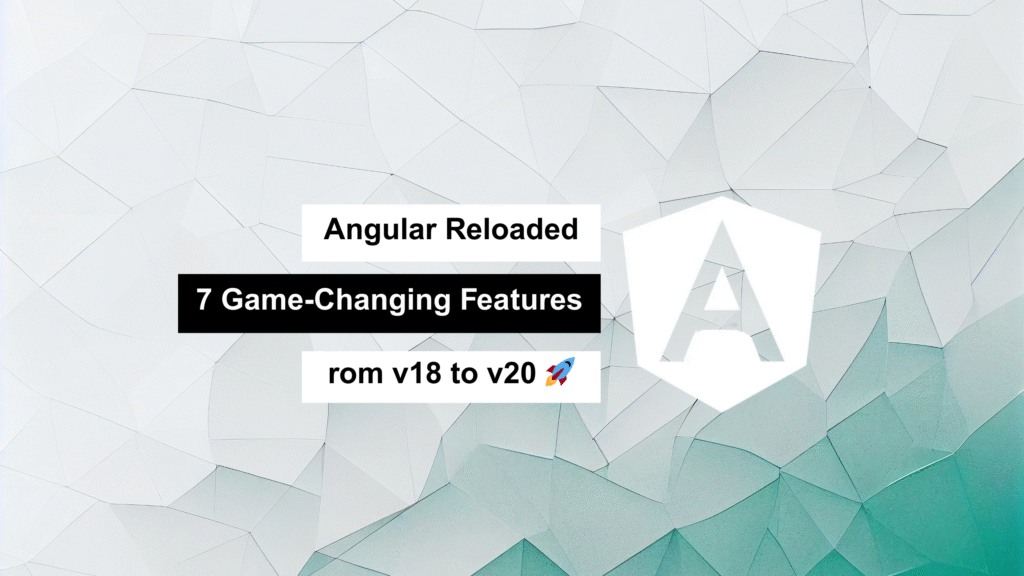
Angular has been going through a serious glow-up. From version 18 through the upcoming v20, we’re seeing the framework transform into a leaner, faster, and more developer-friendly powerhouse.
If you haven’t explored these updates yet, you’re missing out on performance wins and developer ergonomics that could seriously level up your workflow.
Let’s break down the top features that are reshaping Angular’s future — and why they matter.
⚡ Angular 18: Performance Takes Center Stage
Angular 18 focused heavily on speed — both in loading and rendering. And while some features were marked as “experimental,” they’ve proven stable and ready for serious use.
1. ✅ Native Hydration Support
Server-side rendering (SSR) now gets a boost with full hydration support. Just add this to your main.ts:
bootstrapApplication(AppComponent, {
providers: [provideClientHydration()]
});
Why it matters:
Your app will hydrate pre-rendered HTML lightning-fast — improving time to interactive by up to 40%.
2. 🌀 Zoneless Change Detection (Experimental)
Ditch Zone.js and gain control over when your app updates.
@Component({
changeDetection: ChangeDetectionStrategy.OnPush,
providers: [provideExperimentalZonelessChangeDetection()]
})
Why it matters:
Smaller bundles, better performance, and cleaner change detection — especially when paired with signals.
3. 🧠 Deferrable Views with @defer
Lazy load DOM sections using the new @defer syntax:
@defer (when visible)
<app-heavy-widget />
Why it matters:
Skip loading components until they’re needed, speeding up initial paint and improving UX.
⚙️ Angular 19: Signals Change Everything
Angular 19 introduced signals, which bring fine-grained reactivity to the core. They’re simpler and faster than RxJS for many UI patterns.
4. 🧬 Signal-Based Forms
Reactive forms got a modern makeover:
profileForm = signalForm({
name: stringField('', [Validators.required])
});
Why it matters:
Less boilerplate, better performance, and way easier to work with than FormGroup.
5. ✨ New Control Flow Syntax
Say goodbye to verbose structural directives. The new syntax is cleaner and more intuitive:
@if (user())
<p>Welcome, {{ user().name }}!</p>
Why it matters:
Less clutter, more readable templates — and fewer *ngIf gymnastics.
🚀 Angular 20: Previewing the Future
Angular 20 is still in preview, but the features are already shaping the next generation of Angular development.
6. 📦 Faster Compiler, Faster Builds
A brand new compiler pipeline is in the works:
ng build --compiler=pipeline
Early results?
Builds are 60% faster — a huge win for larger apps and teams.
7. 🌐 Simplified File Naming
Angular is embracing clarity over convention:
app.component.ts ➡️ +books.ts
app.component.html ➡️ +books.html
Why it matters:
Focus on what the file is, not what it belongs to. Cleaner file trees = happier devs.
🧭 Angular’s Direction: Where Things Are Headed
Here’s the big-picture shift:
- Hydration → Signals → Zoneless change detection → Compiler overhaul
All of this points to an Angular that’s faster, more reactive, and easier to reason about — while staying true to its structured architecture.
🎯 Final Thoughts
Angular’s evolution from v18 to v20 is more than just new features — it’s a full-on framework renaissance.
Whether you’re building enterprise dashboards, CMS platforms, or interactive apps, these updates give you powerful tools to write cleaner, faster, and more modern Angular code.
Have you tried Signals or Zoneless mode in your project yet?
Drop your thoughts below — let’s nerd out about the future of Angular. 👇
Pro Tip:
Pair ChangeDetectionStrategy.OnPush with provideExperimentalZonelessChangeDetection() for maximum performance:
@Component({
changeDetection: ChangeDetectionStrategy.OnPush,
providers: [provideExperimentalZonelessChangeDetection()]
})
—
🔔 Follow me for more Angular insights, dev tips, and practical guides on building better frontends, faster.
